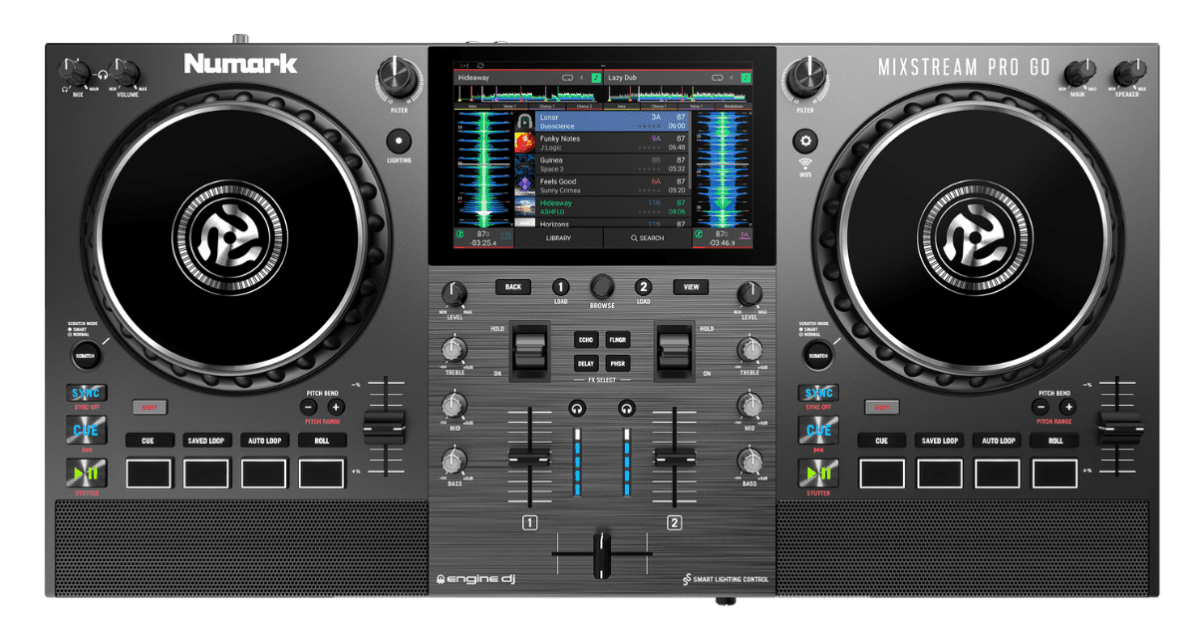The Lowdown
Numark has basically taken its already popular Mixstream Pro and added a rechargeable battery, and in doing so created the world’s first 100% wireless standalone DJ controller. With built in speakers, WiFi for streaming music, an excellent touchscreen and capable built-in DJ software, this is now a true go anywhere, all-in-one, standalone DJ system, and for a great price too. It’s not built for or aimed at pros, but can still do more than most pro DJ systems – even control your home smart lighting, or indeed pro DJ lights. We love it.
Don’t have our latest DJ gear guide? Click here to grab your free copy
Video Review
First Impressions / Setting up
The Numark Mixstream Pro Go feels well built and exciting right from the unpacking. Numark is an entry level brand, but its gear has looked more and more impressive in recent years, with a decent build quality and – in this case – an awful lot of tech packed into its (mainly plastic) casing.
It appears less odd than the Denon DJ Prime Go, another controller from the same wider stable (both Denon DJ and Numark are owned by inMusic). That too runs the Engine DJ operating system that powers the Numark Pro Go, but the Numark unit has much bigger jogwheels, and has got around the issue of having to have a 7″ touchscreen front and centre by opting for short pitch controls, and rearranging the mixer, with the EQ and gain knobs to the left and right of the two channel faders, and the filter knobs in a completely different place (left and right of the screen). The Denon DJ Prime Go is still the more professional of the two units, but this one feels more like a conventional DJ controller.
The position of the speakers is a little odd (they’re where your hands naturally fall when mixing) – but of course if you’ve seen or played on the Numark Mixstream Pro or Pro+ units, this will all seem very familiar. That’s because apart from the addition of the rechargeable battery, the Numark Mixstream Pro Go is exactly the same controller as its stablemates.
You’ll want to charge the internal battery if using away from mains (adaptor provided to do so), and they’ve also provided a USB cable for if/when you wish to connect to a computer, which will usually be to use with DJ software.
Streaming first
Numark is majoring on this being a unit you don’t need to own music to DJ with, so the big information sheet that falls out of the box as you unpack the gear gives you three options for DJing with it, the first of which is simply to connect it to your WiFi and log in to one of the five music streaming services it works with, namely TIDAL, Beatport, Beatsource, Amazon Music Unlimited and SoundCloud Go+. Do that and you can literally be DJing with it in minutes.
Learn to DJ with us: The Complete DJ Course
The other options are to log in to an Engine DJ-analysed library of your own music that you’ve previously uploaded to your Dropbox account, or to use music exported to a USB drive or SD card, plugged into the Numark Pro Go. In both instances you’ll prepare the music using the built-in software’s companion Mac/Windows software, Engine DJ Desktop, which lets you prepare cue points, analyse for beatgrids, build playlists and so on. This remains the most professional way of DJing with this and similar systems.
However, the unit itself is powerful enough to be able to help you do these things, at least in a limited way, even if you just plug in a USB or SD with a pile of MP3s on it. Even if you’re using a streaming service for your music, it pays to have some storage plugged in (we’d recommend a “set-and-forget SD card), because then – cue points, loops and so on that you add to tracks from your music streaming services will be remembered by Engine DJ every time you load them – a neat feature.
Finally, while it is totally possible to plug your own speakers in to this unit (or indeed plug it in at a venue for DJing in public), for practising or even for tiny, living room parties, the built-in speakers will be what you’ll probably start with.
And so, unless you own Philips Hue or Nanoleaf lights (both of which the unit can intelligently control, wirelessly again of course, and which it can connect to instantly), once you’ve logged in to a streaming service of choice, you’re ready to DJ. Simple as that.
In Use
Pretty much everything I wrote in our Mixstream Pro review counts here. Since I wrote that review though, the unit can also integrate with Amazon’s music streaming service as mentioned above – and they’ve refined the Engine DJ software further – see box below.
Engine DJ’s rapid development continues
One of the biggest worries when Engine DJ-powered equipment began to appear was that the platform it relies upon – Engine DJ – would underperform or be neglected. But the opposite has so far proved to be the case.
Recent additions to the software include a “heads up” display for the performance pads on the unit, giving you touchscreen access to them (this is good, because the Mixstreams only have four physical pads but there are eight “buttons” overall that can be used), and a simple sampler for DJ drops and so on – the latter is not available on any other standalone DJ systems, being currently unique to Engine DJ systems.
And with “Smartlists” (aka rules-based “intelligent” playlists), a “day” mode for easier use in daylight, Bluetooth in (for hooking up a phone wirelessly, for instance as a backup source), and – hallelujah – Fuzzy Keymixing (which will make key sync actually useful, and is one of our industry campaign points) all on the way, development continues at a pace.
Read this next: Engine DJ 3.0 Brings A Sampler To Standalone Gear For The First Time
So basically, you’re getting a very smooth, powerful two-channel DJ experience here. The screen, while a bit small for me (it’s the fonts!), is bright, clear and flicker-free: There are also strong rumours of a “day mode” to make it better when DJing in daylight, which will be a great addition when it arrives.
The ability to sync and match musical key at the touch of a button is still mind-blowingly good, and when combined with accurate beatgridding, cues, loop, sync and quantise, makes for addictive mashup-style DJing. The unit is really very good at quick analysis of loaded tracks from streaming services so you can key match them and see their waveforms when DJing, and searching is slick too thanks to the pop-up on-screen keyboard.
The battery’s the thing!
Battery life looks like about three hours, but this depends on the screen brightness you’ve selected and the volume you’re DJing at. Certainly don’t expect it to run all day – but for instance, for an on-location DJ livestream, you’re definitely going to find it runs for long enough. And just to recap from our original review, the speakers are good – not excellent, but surprisingly good for the unit, the price and the size.
As I say though, if you want a deeper insight into how Engine DJ works, this has all been covered in previous reviews. The really big, new thing here is the portability. We loved the Denon DJ Prime Go (it also has a battery), but we needed to take speakers with us to use it. We loved to Mixstream Pro, with its built-in speakers, but needed to power it, so wished it had a battery. And now, with the Mixstream Pro Go, those things have come together. It’s simply excellent.
Conclusion
The whole Engine DJ idea feels like it has come of age in this controller. Think about it: DJing in the past has been an exceedingly geeky thing – hell, we used to build our own gear back in the 70s and 80s! Then there was the record deck age, with its needles, cartridges, slipmats and so on, and the need to have decks and a mixer just to get started. CDJs added flexibility but didn’t reduce the complexity of your average DJ set-up, and controllers – while completely revolutionising DJing – still needed (and need) a separate laptop, speakers and so on, plus a level of understanding of building a local music collection to DJ with.
Read this next: The 7 Most Popular DJ Set-Ups Today
Now, though, for a few hundred (not a few thousand), you can buy a Mixstream Pro Go, log in to a streaming service, and start playing. No need for speakers, cables, a personal music collection – it’s immediate and obvious. And you can do it anywhere. This unit is lightweight, relatively small, and therefore such a revelation. Engine DJ has been designed to offer an immediate yet powerful way of DJing, that’s accessible to all – and nowhere has that been expressed more completely than in the relatively lowly Numark Mixstream Pro Go.
It’s not quite perfect. We still maintain that the 7″ screen does not work as well with the software as the bigger 10″ screen on the Denon DJ Prime 4, for instance (often the fonts are just too small for us in the 7″ screen), but this could be fixed in the software itself. The effects, while fine, are a bit limited. And despite having balanced XLR outputs – which means that the unit could easily hook into a pro PA system – it’s ultimately designed for hobby and home use. An example of this is that while its lighting control is pretty cool, if you want to control pro DMX lights, you’ll need extra hardware and a subscription (the tech it integrates with to do this is called SoundSwitch).
Also worth bearing in mind that standalone systems will always lag behind the best laptop DJ systems. For instance, at the moment the thing missing on all standalones when compared to software is real-time stems separation. But then again, such units do usually give you a laptop software option or two, and in the case of this one, you can use it with Serato and VirtualDJ (although you’ll need to buy or subscribe to those platforms to use them to their full extent).
And – it has to be said that there are still limitations with DJing using streaming services. At some point, DJs will almost certainly want to start their own collections of music. The point is, this system offers you all these options.
DJ like a pro using ANY gear: The Complete DJ Course
Overall then, if what you’re looking for in a DJ gear purchase is a capable, great-sounding, “use anywhere”, and above all fun piece of kit, that works in all kinds of ways, for all types of DJs, this is it. It’ll rock your living room, livestream and house party, right out of the box. Charge it up, and it’ll go to the beach or barbecue with you. And if you happen to have smart lighting from Philips or Nanoleaf in your home, it’ll intelligently hook that in to the show, too.
Want help choosing gear? Grab your free PDF: The Digital DJ Gear Buyer’s Guide
It’s the kind of purchase that your kids will love you for, but that will give you enough power and possibilities for you to be immersed in what it can do long after they’ve gone to bed, too. We love it.


